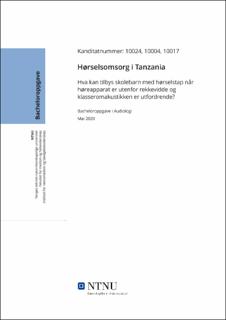| dc.contributor.advisor | Nagaraj, Vinay Swarnalatha | |
| dc.contributor.advisor | Tronstad, Tron Vedul | |
| dc.contributor.advisor | Øygarden, Jon | |
| dc.contributor.author | Gjessing, Bjørn | |
| dc.contributor.author | Glesnes, Tov Bjørnar | |
| dc.contributor.author | Ørland, Ingvild | |
| dc.date.accessioned | 2020-06-20T16:00:28Z | |
| dc.date.available | 2020-06-20T16:00:28Z | |
| dc.date.issued | 2020 | |
| dc.identifier.uri | https://hdl.handle.net/11250/2658902 | |
| dc.description.abstract | Bakgrunn: I Tanzania og mange andre lavinntektsland er det utfordrende å etablere infrastruktur som kan tilby og tilpasse høreapparater som overholder tilfredsstillende standard. Man ønsket i denne studien å se på alternative løsninger som ikke er avhengig av like store ressurser som høreapparat. Disse løsningene skal kunne tilbys skoleelever med hørselstap, og på den måten bedre elevenes sjanse for å få fullført utdannelsen sin. Det som ble undersøkt var effektiviteten til en samtaleforsterker med retningsbestemt mikrofon, et system for trådløs overføring av lyd (RM-system) og det å være nære den som snakker.
Metode: Elever med milde til moderate hørselstap (n = 3, 3, 2) ved tre forskjellige skoler i Kilimanjaroregionen i Tanzania gjennomgikk en tale i støy-test på swahili med og uten hørselshjelpemidler. Testen foregikk i klasserom med kontrollgrupper (n = 40, 25, 35) i tillegg til forsøkspersonene med hørselstap. Det ble utført måling av etterklangstid, bakgrunnsstøy og Speech Transmission Index som resultatene kunne vurderes mot.
Resultat: Det å bruke samtaleforsterker med retningsbestemt mikrofon viste ingen bedring sammenlignet med tilstanden uten hjelpemiddel (p = 0,54). Tilstanden med RM-system og det å flytte seg fram til lydkilden viste begge signifikant bedring (p < 0,001) sammenlignet med tilstanden uten hjelpemiddel. RM-systemet viste best resultater og ga alle forsøkspersonene fullt utbytte. Det å flytte seg fram til lydkilden ga resultater som, for alle unntatt én, var på høyde med kontrollgruppens resultater ved den gjeldende skolen. De akustiske målingene viste utfordrende lytteforhold for alle som oppholder seg i klasserommene ved alle skolene.
Konklusjon: For at de tiltakene som ga gode resultater skal fungere, er elevene med hørselstap avhengig av innsats fra lærerne. Opplysningsarbeid rettet mot lærere rundt hørselstap vil derfor være viktig og nødvendig. Skal RM-systemet fungere som hjelpemiddel i Tanzania, er det avhengig av at det finnes måter å finansiere utstyret på og at det finnes muligheter for opplading og vedlikehold. | |
| dc.description.abstract | Objective: There are challenges associated with establishing an infrastructure that can offer good quality hearing aids and hearing aid fitting in Tanzania and many other low-income countries. These authors wanted to look at alternative solutions that can be used to improve school children with hearing-impairments speech perception that doesn’t dependent as much on this infrastructure. The efficiency of a personal amplifier with a directional microphone, a remote microphone system (RM-system) and the effect of being close to the person who is speaking was tested.
Design: Students with mild to moderate hearing loss (n = 3, 3, 2) from three different schools in the Kilimanjaro region in Tanzania participated in a hearing in noise-test in Swahili. Unaided conditions and using different personal amplification systems was tested. The test was performed in classrooms with a control group (n = 40, 25, 35) in addition to the test subjects with hearing-impairment. Reverberation time, background noise and Speech Transmission Index were also documented.
Result: The condition with a personal amplifier with a directional microphone didn’t show any statistical benefit when compared with the unaided condition sitting in the classroom periphery (p = 0.54). Both the condition with the RM-system and the unaided condition in front of the sound source showed statistical benefit when compared with the unaided condition sitting in the classroom periphery (p < 0.001). All test subjects got highest possible scores when using the RM-system. Moving closer to the sound source led to test-scores on par with the control group average except for one subject. The acoustic measurements revealed challenging listening conditions for everyone occupying the classroom.
Conclusion: Because both solutions that gave good results require cooperation from the teachers, a good direction forward would be to work on raising teacher’s awareness on hearing loss. To get the RM-system to work in Tanzania, solutions to the financial aspect needs to be in place in addition to solutions for charging batteries and repairment of the equipment. | |
| dc.publisher | NTNU | |
| dc.title | Hørselsomsorg i Tanzania - Hva kan tilbys skolebarn med hørselstap når høreapparat er utenfor rekkevidde og klasseromakustikken er utfordrende? | |
| dc.type | Bachelor thesis | |
